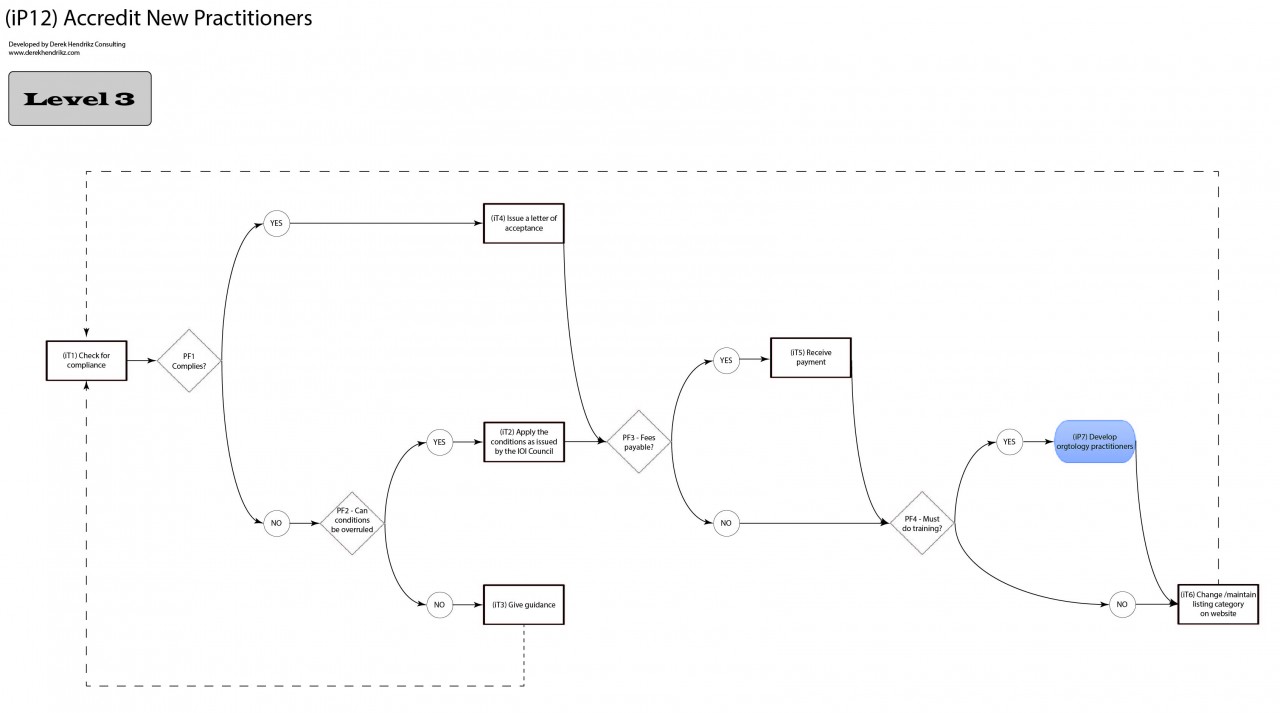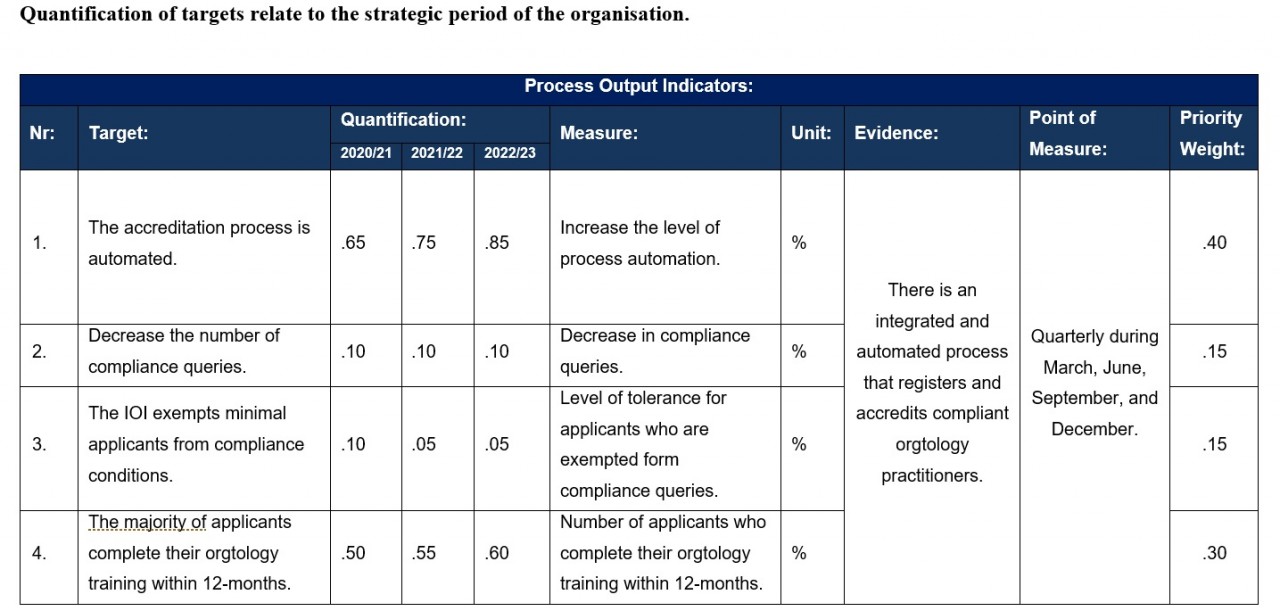The Orgtology Blog
Create efficiency through output targets
"You can't manage what you can't measure."
Peter Drucker
Outputs are results that a process cycle produces. Outcomes are different. They show how an environment perceives these results. Efficiency drives outputs whilst effectiveness creates outcomes. In so, outputs and outcomes define the results of Org.
Targets predict these results. We will always measure the results of Org against either performance or relevance. Output targets will predict performance whilst outcome targets will estimate relevance.
Organisations have different names for targets. E.g., we often call output targets operational targets, KPI's, or production goals. We draw these targets from a process construct. In that, what we measure becomes an indicator of performance.
A target predicts a result. Performance is the deviation between such prediction and the actual result. Output targets enables Org to predict its performance. That is because output targets are the key indicators of its performance.
To create output targets, one must find the indicators that measures the performance of a process construct. When done, we must quantify them. The last step is to rank and relate them. In this essay, I explain this process.
The basic assumption on output targets
If the movement of activity create outputs, then Org should be able to predict what these outputs will be. This is because processes cycle, which means we understand what they can do, because it is not the first time that it is done.
An output is an indicator of performance. The test for performance is always efficiency. This means that we must get out, more than what we put in. If this is not the case, then the energy used to perform will not be able to sustain. In so, to create an output target, directly implies an understanding of efficiency.
The mechanics of an output target
An output target drives efficiency whilst an outcome target estimates effectiveness. This is their main difference. Org must control its efficiency measures. E.g., quality cannot be an efficiency measure since it is a perception. Of course, one can set quality standards. Yet, that still does not mean that everyone will perceive quality. E.g., one might set a "genuine leather" quality standard through high-quality cattle leather. But those who buy the product might see kudu leather as high- and cattle leather as low- quality. Efficiency measures must relate to items that one can precisely quantify. These will be time, cost, quantity, etc. There can be no ambiguity when measuring efficiency.
A target is only relevant if it is possible to deviate from a planned output. Where no deviation is possible, the process becomes a procedure. The main difference between a process and a procedure is that we cannot deviate from a procedure. In so, procedures do not have targets. They work on rules. It must happen as stipulated.
To control a process, we have both rules and targets. Jointly they ensure efficiency. In my experience, many process engineers confuse these things. E.g., to hand in a report by the first of every third month is not a target, it is a rule. To tolerate a 10% average on reports that are handed in late, is a target. Therefore, an output target should drive one of three things. It should either increase, decrease, or tolerate some quantifiable item.
Mostly, people struggle to distinct processes from procedures. The reality is that they relate but are different. We govern rules through policy statements. In turn, we explain policy through procedures. Where there is NO possibility of deviation, the flow of activity becomes a procedure. Where there is possibility of deviation one uses targets to control efficiency. E.g., accounting has no targets since it is not possible to deviate from the activity flow. The books can never "sort of" balance. It either balances or it does not. In so, financial accounting will run on procedures. Something such as sales will have targets since it is possible to sell more or less than planned.
Exceeding output targets
I often hear people brag about how they exceeded targets in excessive numbers. E.g., target achieved by 200%. Mostly companies celebrate and reward this type of deviation. Yet, it holds immense risk. Of course, it might create a new norm, which is a good thing. Unfortunately, it is more often the case of an inability to predict capability.
The whole aim of efficiency is to reduce performance risk. Uncertainty creates risk. Where you aim to produce 10 units and you produce 20, chances are high that you have no idea what you're doing. Why companies celebrate such stupidity is beyond me. As rule of thumb, I propose that one should tolerate 20% "over achievement" and 10% "under achievement". In that way we force precise predictions. This would be the basis of high performance at minimal risk.
So, a salesperson makes 1 million USD of sales per year. Give and take 10% to the left or the right, she has been consistent in achieving this target. Then, one year, with a clever tactic and a bit of luck, she doubles that. Does this mean that she is a "rouge cowboy"? Probably not.
To know how much of a target one can exceed, one must grasp potential. Where we measure performance against time, cost, and energy, there is an exact ceiling. A day has 24-hours, a budget does not have infinite money, and one person can only do so much. Usain Bolt cannot beat his own 100 metre Olympic record of 9.58 seconds by 5 seconds. It is not humanly possible. In these examples we have a scope of potential. In sales this is often not the case. The more we understand potential, the more exact our targets will be. Excessive exceeding of targets show that we lack methods of accurately assessing potential.
When we do excessively exceed a target, we must learn how and why it was possible. Such learning will help us to create new process intelligence. In so, we create a new norm.
In precis, our grasp of potential will create the level at which we can tolerate deviation. In my experience, many units and employees lie about their performance targets to get a bonus. The bliss is not worth the risk.
How to identify output targets
To spot a target, we must study its purpose and process flow. We begin with frontline processes. The rule in process engineering is that we develop from top to bottom, but target from bottom up.
Below is an example of the IOI's "accredit new practitioners" process. The purpose of this process is that "there is an integrated and automated process that registers and accredits compliant orgtology practitioners."
Questions that one can ask to find output targets for a process are:
- What must this process do?
- How will we measure its efficiency?
- What is its historical performance?
- How far can we stretch its ability?
Process flow begins in purpose. Knowing why a process exists, will help one to find its targets. The underlying aim of any process is efficiency. In so, we must find the things that makes a process inefficient. In the example below, the purpose of the process is to integrate and automate the orgtology practitioner's accreditation process.
Rules vs. targets
Org needs both targets and rules, to drive a process cycle. The first step is to probe the things that could make a process inefficient. In the above given example human intervention in any of the activity will slow down the process and incur cost.
Therefore, the following things might threaten efficiency of this process:
- Where guidance on how to comply is unclear, it will cause frustration and force human intervention.
- Lack of clarity on how to overrule compliance conditions will force human intervention.
- Not knowing what type and how much of training an applicant needs will force human intervention.
- Final accreditation and listing of a practitioner depend on a sub-process (iP7). Therefore, inefficiency in iP7 will create a bottle neck for the entire process.
The next step is to list the possible rules and targets that will ensure process efficiency. The table below gives an example. We will ensure the rules through policies and explain these policies though procedures. Both targets and rules must be incorporated into a performance assessment system. That is how one controls a process.
Action programs for targets
In traditional approaches, targets have action programmes. In orgtology, we reject the idea of an action programme. All activity is either repetitive or non-repetitive. Outputs are the results of a repetitive process. A target is the estimation of what an output will be. What would be the need for an action program in this? There is already a process that generates results. The target simply aims to measure these results. The action program thus already exists in the form a process.
Often the action program is in the form of a project. E.g., Target: "Increase applicants who complete their training within 12-months by 20%." Since the training is research based, the IOI would want to favour applicants with master's degrees. This is because these applicants have a strong research background. It will enable them to do their examination essays faster. To do this, the IOI must launch a project that changes the "applicant selection" algorithm. A project plan will thus define the action. Therefore, there is no added action plan needed since there is a project plan. On completion, this project will turn into a process.
Constructing and quantifying output targets
The steps below explain how to construct and define output targets. The table below gives an example of how this is done. The steps are…
(1) Define the target:
It is best to define an output target in a "current" and not a "future" state. E.g., "To decrease the number of compliance queries" defines a future state. "The IOI has an acceptable amount of compliance queries" defines an ongoing reality. As mentioned, an output target measures the capacity of a process output on a specific date and time.
(2) Quantify the target:
It is preferable that one uses a percentage to quantify targets. This is a guideline and not a rule. Things tend to show meaningful perspective when one benchmarks them against 100 points. E.g., Is a $27 009 000 sales turnover high or low? But, if we say "10% increase in sales turnover", we have a meaningful perspective of what we want to achieve.
Quantification must be numerical. To measure anything there must be homogenous units of something. Also, it makes sense to run operational targets within a strategic period. E.g., if a strategic period is three years, then there must be quantified targets for each of the three years.
(3) Evidence:
When we achieve our targets, the process is working. Therefore, subsistence of process purpose is evidence that we have the right rules and targets in place.
(4) Point of measure:
This is the date and time when we measure our target achievement. It is good practice to measure annual targets quarterly. In that way one can act early enough if things go wrong.
(5) Priority Weight:
This is the importance of a target, expressed as a percentage. Targets are not equal in terms of importance. Therefore, the weight of a target will significantly influence a target score. E.g., My performance measures for today are: (1) wake up; (2) have breakfast; (3) travel to work; and (4) present a training session. Can I claim 75% performance if I do three of these four things? Of course not – they are not equal. If "present a training session" weighs 80%, and I did not do it, my performance is only 20%.
Conclusion
"Clean your room."
Jordan Peterson
In my experience there is a direct correlation between process efficiency and success. Efficiency creates order. I have had the privilege to work in about 27 countries to date. Some wealthy and others poor. Where I enter wealthy countries, I see efficient processes. The opposite is true for impoverished countries. When I probe this, people tell me that there is no money for efficiency. Yet, in poor countries I often see a high tolerance for corruption. Oversized governments tend to support wealthy politicians. Contrarywise, wealthy countries seem much more conservative on how they spend their money.
I must have been on tens of dozens of airports during my consulting career. In my experience, what one finds on a national airport is what one will experience in the country. Meaningless checkpoints, unclear flow, excessive staff, etc., reflects inefficiency. Where this is the case, one is bound to find inefficiency beyond the airport gates. E.g., traffic that does not flow, civil service that does not deliver, companies that do not produce, etc. It seems that inefficiency breeds inefficiency. The same rule applies for efficiency. Wealthy countries mostly have flawless process efficiency.
What goes for a country, goes for a government, goes for company, and in so, goes for a person. Where countries are inefficient, people seem miserable. Everyone fends for the crumbs of a looted cake. Taxis break rules to maximise profits, crime increases, discrimination and prejudice flourishes, etc. Without clear rules, efficient flow, and predefined outputs, poverty will rule. This is a sad cycle of injustice where politics drive a system that thrives on illogical needs. The consequence of inefficiency is chaos.
Targets and rules drive efficiency. They are more important than one can ever imagine.

Join the Orgtologist Certification Program (OCP) - Empowering Executive Teams Worldwide
Copyright
© 2018: CFT Hendrikz
When you subscribe to the blog, we will send you an e-mail when there are new updates on the site so you wouldn't miss them.







